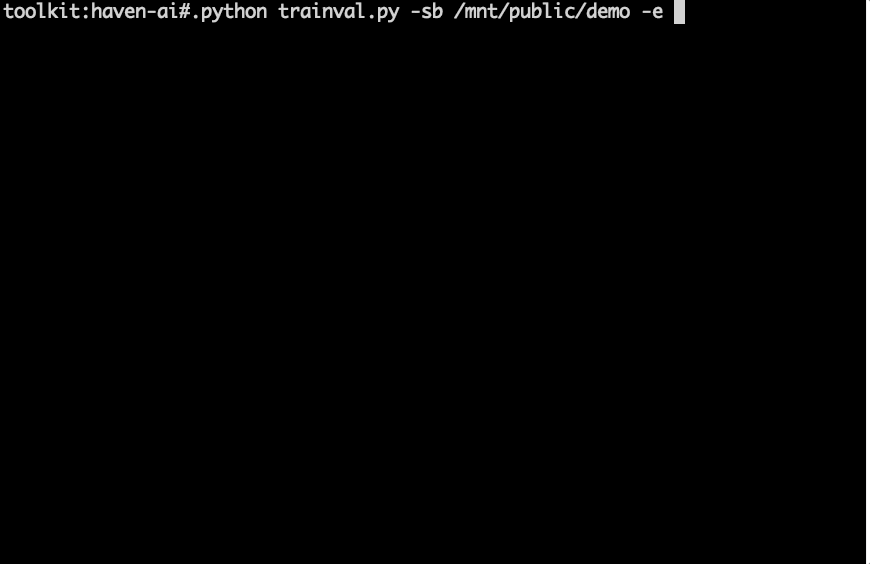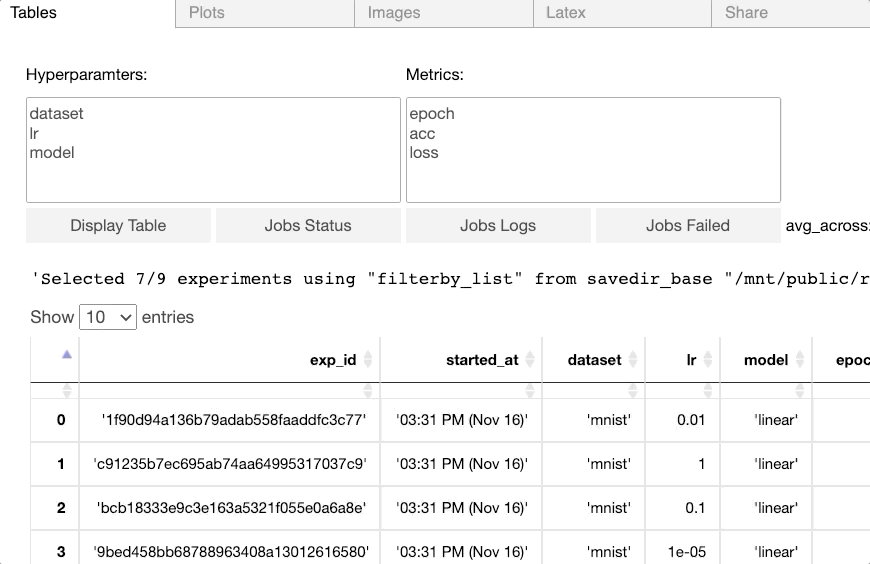Try out the Google Colab Demo || See Papers that are based on Haven-AI
Create a Benchmark with these 4 Steps
(1) Setup Experiments| (2) Run Experiments| (3) Visualize Experiments| (4) Run Experiments in Cluster
| Launch Experiments on Cluster | Visualize Experiments on Jupyter |
 |
 |
pip install --upgrade git+https://github.com/haven-ai/haven-ai
Create trainval.py file and add the following code,
import tqdm
import os
from haven import haven_examples as he
from haven import haven_wizard as hw
# 1. define the training and validation function
def trainval(exp_dict, savedir, args):
"""
exp_dict: dictionary defining the hyperparameters of the experiment
savedir: the directory where the experiment will be saved
args: arguments passed through the command line
"""
# 2. Create data loader and model
train_loader = he.get_loader(name=exp_dict['dataset'], split='train',
datadir=os.path.dirname(savedir),
exp_dict=exp_dict)
model = he.get_model(name=exp_dict['model'], exp_dict=exp_dict)
# 3. load checkpoint
chk_dict = hw.get_checkpoint(savedir)
# 4. Add main loop
for epoch in tqdm.tqdm(range(chk_dict['epoch'], 10),
desc="Running Experiment"):
# 5. train for one epoch
train_dict = model.train_on_loader(train_loader, epoch=epoch)
# 6. get and save metrics
score_dict = {'epoch':epoch, 'acc': train_dict['train_acc'],
'loss':train_dict['train_loss']}
chk_dict['score_list'] += [score_dict]
hw.save_checkpoint(savedir, score_list=chk_dict['score_list'])
print('Experiment done\n')
# 7. create main
if __name__ == '__main__':
# 8. define a list of experiments
exp_list = [{'dataset':'syn', 'model':'linear', 'lr':lr}
for lr in [1e-3, 1e-4]]
# 9. Launch experiments using magic command
hw.run_wizard(func=trainval, exp_list=exp_list)Run the following command in terminal,
python trainval.py --reset 1 -v trainval_results.ipynb --savedir_base ../results
Optional arguments,
-h, --help show this help message and exit
-e EXP_GROUP_LIST [EXP_GROUP_LIST ...], --exp_group_list EXP_GROUP_LIST [EXP_GROUP_LIST ...]
Define which exp groups to run. (default: None)
-sb SAVEDIR_BASE, --savedir_base SAVEDIR_BASE
Define the base directory where the experiments will be saved. (default: None)
-d DATADIR, --datadir DATADIR Define the dataset directory. (default: None)
-r RESET, --reset RESET Reset or resume the experiment. (default: 0)
-ei EXP_ID, --exp_id EXP_ID Run a specific experiment based on its id. (default: None)
-j RUN_JOBS, --run_jobs RUN_JOBS Run the experiments as jobs in the cluster. (default: 0)
-nw NUM_WORKERS, --num_workers NUM_WORKERS
Specify the number of workers in the dataloader. (default: 0)
-v VISUALIZE_NOTEBOOK, --visualize_notebook VISUALIZE_NOTEBOOK
Create a jupyter file to visualize the results. (default: )Step 2 creates trainval_results.ipynb, open the file on Jupyter to get tables and plots
You can launch Jupyter with,
jupyter nbextension enable --py widgetsnbextension --sys-prefix
jupyter notebookIf you have access to the ElementAI cluster api then you can run the experiments in cluster (slurm option coming soon),
python trainval.py --run_jobs 1 --reset 1
| Codebase Structure | Result Folder Structure |
project/
├── src/
│ ├── __init__.py
│ ├── datasets.py
│ └── models.py
├── scripts/
│ └── train_on_single_image.py
├── exp_configs.py
├── README.md
└── trainval.py # a copy of the code
|
results/
├── experiment_1/
│ ├── code/ # a copy of the code
│ ├── images/ # qualitative results
│ ├── exp_dict.json # defines the hyperparameters
│ ├── score_list.pkl # list of scores saved each epoch
│ ├── model.pth # saved model state
│ └── job_dict.json # contains the job info
|
- COVID19: https://www.elementai.com/news/2020/accelerating-the-creation-of-ai-models-to-combat-covid-19-with-element-ai-orkestrator
- LCFCN: https://github.com/ElementAI/LCFCN
- Embedding Propagation: https://github.com/ElementAI/embedding-propagation
- Bilevel Augmentation: https://github.com/ElementAI/bilevel_augment
- SSN optimizer: https://github.com/IssamLaradji/ssn
- SLS optimizer: https://github.com/IssamLaradji/sls
- Ada SLS optimizer: https://github.com/IssamLaradji/ada_sls
- SPS optimizer: https://github.com/IssamLaradji/sps
- Fish Dataset: https://github.com/alzayats/DeepFish
- Covid Weak Supervision: https://github.com/IssamLaradji/covid19_weak_supervision
-
Haven is a library for building, managing and visualizing large-scale reproducible experiments. It helps developers establish a workflow that allows them to quickly prototype a reliable codebase. It also helps them easily scale that codebase to one that can run, manage, and visualize thousands of experiments seamlessly.
-
The library provides a wide range of functionality including best practices for defining experiments, checkpointing, visualizing and debugging experiments, and ensuring reproducible benchmarks.
-
This library could strongly boost productivity for building great products, winning machine learning competitions, and getting research papers published.
-
The only structure required is that each experiment has the following.
<savedir_base>/<exp_id>/exp_dict.jsonthat defines a single set of hyperparamters as a pythondict.exp_idis the hash of that hyperparameter pythondict.<savedir_base>/<exp_id>/score_list.pklthat has a list of dicts where each dict contains metrics as keys with scores as their values.
project/
├── src/
│ ├── __init__.py
│ ├── datasets.py
│ └── models.py
├── scripts/
│ ├── visualize_mnist.py
│ └── train_on_single_image.py
├── exp_configs.py
├── README.md
└── trainval.py
We love contributions!

